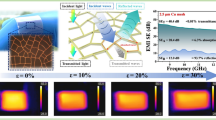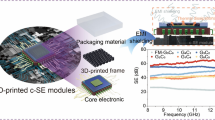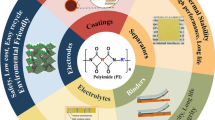Abstract
Unileg-type thermoelectric generators have proven to be a good choice for high-temperature applications, because their composition from a single thermoelectric material avoids different thermal expansion coefficients, giving the structure good mechanical strength and increased lifespan during thermal cycling. These structures are usually composed of a thermoelectric pellet with metallic electrical conductors joining the hot and cold ends of consecutive pellets. The novel unileg structure described herein is designed to deal with one of the main issues with traditional devices, viz. the physical and chemical stability of the solder between the pellet and the conductor at the hot side. The material for which this structure is proposed is a p-type Ca3Co4O9 semiconductor oxide, due to its chemical stability at high temperature and good machinability. This final requirement is related to the main innovation of the structure, viz. a partial cut that divides the pellet longitudinally, leaving two legs joined by an uncut section, forming a section similar to the letter Π. The metallic conductor stripe usually employed in unileg thermoelectric generator manufacturing is replaced by a coating of conductive material, in this case silver, on one of the legs resulting from the cut. Due to these operations, one of the legs is practically short-circuited and acts as an electrical conductor for the unileg structure, eliminating the need for soldering at the hot end of the pellet.
Similar content being viewed by others
References
L. Young and B. Bairstow, Radioisotope power systems reference book for mission designers and planners. (Jet Propulsion Laboratory, National Aeronautics and Space Administration, 2015), http://hdl.handle.net/2014/45467. Accessed 30 Nov 2018.
KRYOTHERM, Ltd., Thermoelectric generators operating on gas fuel. (KRYOTHERM, Ltd., 2016), http://kryothermtec.com/thermoelectric-generators-operating-on-gas-fuel.html. Accessed 30 Nov 2018.
J.W. Fergus, J. Eur. Ceram. Soc. (2012). https://doi.org/10.1016/j.jeurceramsoc.2011.10.007.
K.H. Bae, S.-M. Choi, K.-H. Kim, H.-S. Choi, W.-S. Seo, S. Lee and H.J. Hwang, J. Electron. Mater. (2015). https://doi.org/10.1007/s11664-015-3694-8.
S. Lemonnier, C. Goupil, J. Noudem, and E. Guilmeau, J. Appl. Phys. (2008). https://doi.org/10.1063/1.2951796.
E. Sudhakar Reddy, J.G. Noudem, S. Hebert and C. Goupil, J. Phys. D Appl. Phys. (2005). https://doi.org/10.1088/0022-3727/38/19/026.
H. Suda and J. Sato, Thermoelectric conversion module. U.S. Patent No. 9.537.076, 3 January 2017.
H. Suda, T. Nemoto, and J. Sato, Thermoelectric conversion module. U.S. Patent No. 10,003,003, 19 June 2018.
W. Wijesekara, L. Rosendahl, D.R. Brown, and G.J. Snyder, J. Electron. Mater. (2015). https://doi.org/10.1007/s11664-014-3569-4.
M.A. Madre, I. Urrutibeascoa, G. Garcia, M.A. Torres, A. Sotelo, and J.C Diez, J. Electron. Mater. (2018). https://doi.org/10.1007/s11664-018-6748-x
A.D. Gardea, R. Nishimoto, N.Y.C. Yang, A.M. Morales, S.A. Whalen, J.M. Chames, and W.M. Clift, Material compatibility and thermal aging of thermoelectric materials (Sandia National Laboratories, 2009). https://prod.sandia.gov/techlib-noauth/access-control.cgi/2009/095968.pdf. Accessed 30 Nov 2018.
S. LeBlanc, S.K. Yee, M.L. Scullin, C. Dames, and K.E. Goodson, Renew. Sustain. Energy Rev. (2014). https://doi.org/10.1016/j.rser.2013.12.030.
W.-C. Lin, Y.-S. Li, and A.T. Wu, J. Electron. Mater. (2018). https://doi.org/10.1007/s11664-017-5906-x.
M.A. Torres, G. Garcia, I. Urrutibeascoa, M.A. Madre, J.C. Diez, and A. Sotelo (2018). https://doi.org/10.1007/s40843-018-9339-1
J.M. Gordon, Am. J. Phys. (1991). https://doi.org/10.1119/1.16818.
L.F. Richardson and J.A. Gaunt, Philos. Trans. R. Soc. A. (1927). https://doi.org/10.1098/rsta.1927.0008.
W.-H. Chen, P.-H. Wu, X.-D. Wang, and Y.-L. Lin, Energy Convers. Manag. (2016). https://doi.org/10.1016/j.enconman.2016.09.039.
F.J. Cheng, Z.L. Ma, Y. Wang, G.X. Zhang, and W.M. Long, Kovove Mater. (2014). https://doi.org/10.4149/km_2014_3_157.
Ferrotec Corporation USA, Thermoelectric Technical Reference. Reliability of Thermoelectric Cooling Modules. (Ferrotec Corporation USA, 2015), https://thermal.ferrotec.com/technology/thermoelectric-reference-guide/thermalref10/. Accessed 30 Nov 2018.
Acknowledgments
The Regional Development Agency of the Basque Country (SPRI) is gratefully acknowledged for economic support through the research project “High Temperature Oxide Module” (HITOM), KK-2017/00099, Programa ELKARTEK.
Author information
Authors and Affiliations
Corresponding author
Rights and permissions
About this article
Cite this article
García, G., Martínez-Filgueira, P., Cordon, M. et al. Π Unileg Thermoelectric Structure for Cycling Robustness at High Temperature and Low Manufacturing Cost. J. Electron. Mater. 48, 2010–2017 (2019). https://doi.org/10.1007/s11664-019-06944-x
Received:
Accepted:
Published:
Issue Date:
DOI: https://doi.org/10.1007/s11664-019-06944-x




